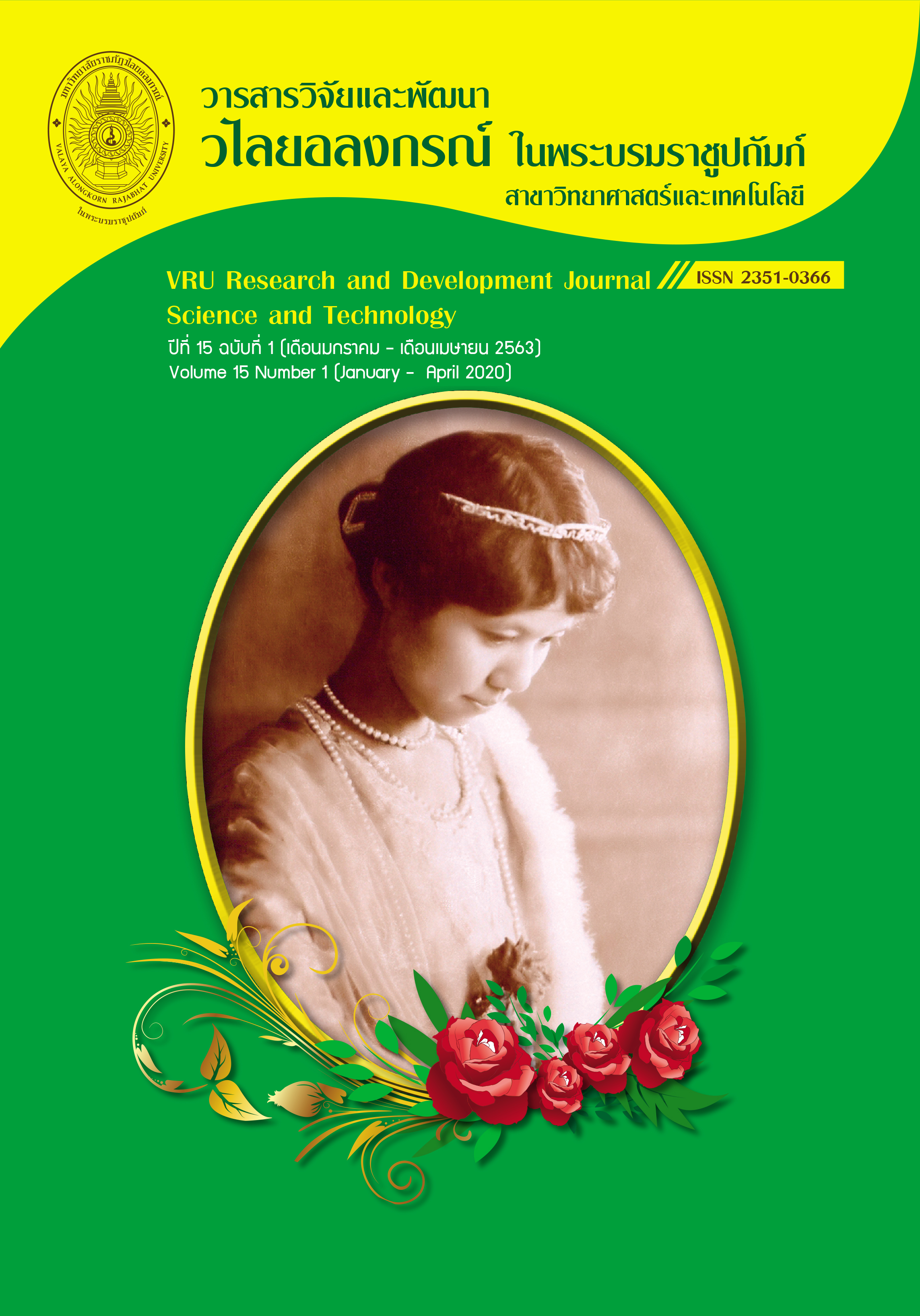ANTIOXIDATION ACTIVITY AND TYROSINASE INHIBITION ACTIVITY FROM CRUDE EXTRACTS OF PSIDIUM GUAJAVA L.
Main Article Content
Abstract
The aim of present study is to screen the phytochemical, total phenolic content, total tannin content, total flavonoid content antioxidant activity and tyrosinase inhibition activity of guava leaves (Psidium guajava L.). The guava leaves were extraction by ethanol. The crude extracts from guava leaves were analized total phenolic content, total tannin content, total flavonoid content, antioxidant activity using DPPH radical scavenging method and tyrosinase inhibition activity using dopachrome method. In this study, the phytochemical screening of guava leaves extracts were flavonoids, coumarns, saponins, tannins and phlobatannins. The extracts showed the highest total phenolic content and total flavonoid content which was of about 138.89±0.04 mg GAE/g, 157.56±0.02 mg TAE/g 45.29±0.05 mg QE/g, respectively. The antioxidant activity using DPPH radical scavenging method extracts of guava leaves showed the highest antioxidant activity with EC50 values of 12.11±0.08 mg/mL. Tyrosinase inhibition activity using dopachrome method extracts showed tyrosinase inhibition activity with EC50 values of 10.09±0.04 mg/mL.
Downloads
Article Details
Copyright Notice
The copyright of research articles published in the VRU Research and Development Journal Science and Technology Journal belongs to the Research and Development Institute, Valaya Alongkorn Rajabhat University under the Royal Patronage. Reproduction of the content, in whole or in part, is prohibited without prior written permission from the university.
Responsibility
The content published in the VRU Research and Development Journal Science and Technology Journal is the sole responsibility of the author(s). The journal does not assume responsibility for errors arising from the printing process.
References
ณพัฐอร บัวฉุน. (2558). สารต้านอนุมูลอิสระและปริมาณสารฟีนอลิกรวมของสารสกัดจากชะเอมไทย, วารสารวิจัยและพัฒนา วไลยอลงกรณ์ ในพระบรมราชูปถัมภ์ สาขาวิทยาศาสตร์และเทคโนโลยี, 10(2), 78-95.
ณพัฐอร บัวฉุน, และเยาวนารถ งามนนท์. (2561). การพัฒนาโลชั่นบำรงผิวจากสารสกัดหยาบชะเอมไทยและพิลังกาสา, วารสารวิจัยและพัฒนา วไลยอลงกรณ์ ในพระบรมราชูปถัมภ์ สาขาวิทยาศาสตร์และเทคโนโลยี, 13(2), 74-85.
ณิชาภัทร ฟองเทพ, ปริยาพร ยอดรัก, และเกรียงศักดิ์ ไทยพงษ์. (2558). คุณภาพผลและปริมาณสารต้านอนุมูลอสิระในฝรั่งพันธุ์แป้นสีทองเกรดต่าง ๆ, วารสารวิทยาศาสตร์เกษตร, 46(3)(พิเศษ), 505-508.
ปรานอม ขาวเมฆ, และวิลาวัลย์ จันทนู. (2559). ฤทธิ์ต้านอนุมูลอิสระและฤทธิ์ยับยั้งเอนไซม์ไทโรซิเนส
จากใบและผลของผลไม้สดและอบแห้งและการผลิตครีมบํารุงผิว. การประชุมวิชาการระดับชาติ มหาวิทยาลัยรังสิต ประจําปี 2559 (RSU National Research Conference 2016) 29 เมษายน 2559. 75-84.
Anonymous (2006). Microbiology of food and animal feeding stuffs - horizontal method for detection and enumeration of Campylobacter spp. Geneva: International organisation of standardization.
Ayoola, G. A., Coker, H. A. B., Adesegun, S. A., Adepoju-Bello, A. A., Obaweya, K., Ezennia, E. C., & Atangbayila, T. O. (2008). Phytochemical screening and antioxidant activities of some selected medicinal plants used for malaria therapy in southwestern nigeria, Journal of pharmaceutical research, 7(3), 1019–1024.
Chua, L. S. (2016). Untargeted MS-based small metabolite identification from the plant leaves and stems of Impatiens balsamina. Plant physiol biochem, 106:16-22
Ebanks, J. P., Wickett R. R., & Boissy R. E. (2009). Mechanisms regulating skin pigmentation: the rise and fall of complexion coloration, International journal of molecular sciences. 10(9), 4066–4087.
Fernandes, M. R. V, Dias, A. L. T., Carvalho, R. R., Souza, C. R. F., & Oliverira, W. P. (2014). Antioxidan t and antimicrobial activities of Psidium guajava L. spray dried extracts, Industrial crops and products, 60, 39-44.
Jime nez-Escrig, A., Rinco, M., Pulido, R., & Saura-Calixto, F. (2001). Guava Fruit (Psidium guajava L.) as a New Source of Antioxidant Dietary Fiber, Journal of agricultural and food chemistry, 49, 5489-5493.
Kim, Y-J., & Uyama. H. (2005). Tyrosinase inhibitors from natural and synthetic source: structure, inhibition mechanism and prospective for the future. Cell. Mol. Life Sci. 62: 1707-1723
Koleva, I. I., BeeK, T., Linseen, J. P. H., Groot, A., & Evstatieva, L. N. (2002) Screening of plant extracts for antioxidant activity: a comparative study on three testing methods, Phytochemical analysis, 13(1), 817-821.
Liyana-Pathirana, C. M., Shahidi, F., & Alasalvar, C. (2006) Antioxidant activity of cherry laurel fruit (Laurocerasus officinalis roem.) and its concentrated juice, Food chemistry, 99, 121-128.
Okonogi, S., Duangrat, C., Chowwanapoonpohn, S., & Anuchapreeda, S. (2007). Research of antioxidant from thai medicinal plants, National research council of thailand.
Pisoschi, A. M., & Negulesc, G. P. (2011). Methods for total antioxidant activity determination: a review, Biochemistry and analytical biochemistry, 1(1), 1-10.
Prommuak, C., D-Eknamkul, W., & Shotipruk, A. (2008). Extraction of flavonoids and carotenoids from thai silk waste and antioxidant activity of extract, Separation and purification technology, 62, 444-448.
Ramadan, M. F., Kroh, L. W., & Moersel, J. T. (2003). Radical scavenging activity of black cumin (Nigella sativa L.), coriander (Coriandrum sativum L.) and niger (Guizotia abyssinica Cass.) crude seed oils and oil fractions, Journal of agricultural and food chemistry, 51, 6961-6969.
Ramsden, C. A., & Riley P. A. (2014). Tyrosinase: The four oxidation states of the active site and their relevance to enzymatic activation, oxidation and inactivation, Bioorganic and medicinal, 22(8), 2388–2395.
Solano, F., Briganti, S., Picardo, M., & Ghanem, G. (2006). Hypopigmenting agents: an updated review on biological, chemical and clinical aspects. Pigment Cell Res, 19: 550-571.
Tsai, C. C., Chen, H. S., Chen, S. L., Ho, Y. P., Ho, K. Y., & Wu, Y. M. (2005). Lipid peroxidation: a possible role in the induction and progression of chronic periodontitis, Journal periodontal, 40, 378–384.
Venkatesh, B., & Dorai, A. (2015). Antibacterial and antioxidant potential of white and pink nelumbo nucifera gaertn flowers. In Proceeding of international conference on bioscience, biochemistry and bioinformatics IPCBEE, 213-217.


